Content
Shiitake mushroom (aka shiitake) comes from eastern countries, the Chinese and Japanese value it no less than the healing ginseng root, due to its high content of nutrients.
The cultivation of shiitake mushrooms in artificial conditions began precisely in those regions, gradually the technology "migrated" to us, the mushroom is cultivated both for amateur and commercial purposes. Shiitake is not capricious and, subject to certain conditions, gives good yields; it is one of the most aromatic, tasty and rich in composition mushrooms.
About shiitake
In the wild, the shiitake mushroom actively grows in the foothills of Japan, Korea, and China. He does not like lowlands, excessive heat and frost. It is practically not found in Europe and hot countries, and in Russia it can be found only in some regions of Siberia and the Far East.
Shiitake belongs to the group of saprophytes, that is, it feeds on the organic matter of the wood on which it grows. Gradually, the stumps with myceliums are destroyed.
Outwardly, it is an ordinary medium-sized hat mushroom. The diameters of the caps vary from 5 to 20 cm in diameter, the legs of the fruit are thin. The hat has a patterned color similar to a turtle's shell and ranges from cream to dark brown.
The mushroom is fleshy, very aromatic, contains a large amount of trace elements and vitamins.

Growing shiitake mushrooms at home gives good results, the mushroom is unpretentious if placed in the right environment.
Due to the fact that shiitake prefers high-mountainous regions, sea air and a temperate climate, in our area it is very difficult to grow it in nature (in vegetable gardens, in plots). For artificial reproduction, you will have to allocate a separate room: a basement, a shed, a hangar, in which special conditions will need to be created. Some people manage to grow shiitake right in the apartment, on the balcony.
Technology for growing shiitake mushrooms at home
The most optimal way to grow shiitake mushrooms in artificial conditions is to use bags and a substrate. The blocks are placed in a prepared room and the conditions for fruit propagation are observed.
Room preparation
To breed shiitake indoors, it is necessary to create good ventilation, lighting of at least 100 lux and an air temperature control system. Mushrooms love warmth during the day and cool at night. The optimum daytime temperature for them is + 15-18 ºC, at night - + 10 ºC. During the sowing period and until the moment of fruiting, the temperature is raised to +25 ºC. Air humidity is maintained within 70-80%. A drip irrigation system is recommended for irrigation.
The room must be clean, completely disinfected; for the convenience of placing myceliums, it is better to use racks with shelves.
Shiitake mycelium
Since the mushroom grows only in a certain region of our country, it is not possible to collect its mycelium on your own in the wild. The easiest way to buy seed is from a shop or Shiitake commercial plant.
The seller is obliged to indicate on the packaging the date of harvesting the mycelium, the shelf life and the conditions necessary for the content of the material.

Substrate preparation
For the substrate, you can use sawdust of trees with an admixture of dry leaves, hay, sunflower husks.
The material must be sterilized to destroy all harmful microorganisms. To do this, the mixture is placed in water and boiled for about two hours, then cooled and wrung out.
Packages also need to be processed. The easiest way is to rinse them in a chlorine solution. The substrate is laid out in bags raw, alternating layers with mycelium (each block should account for no more than 8% of mycelium). The edge of the bag is tied with a rope.
Then the mushroom blocks are laid out on shelves at a short distance from each other. Each bag is cut with a clean, sterilized knife or blade (up to 20 holes per block).
All work should be carried out with gloves and in the most sterile conditions so that harmful microbes do not get into the mycelium.
Incubation period
The cultivation of shiitake mushrooms largely depends on the correct observance of the conditions for incubation, which lasts an average of about three weeks. All this time, the temperature in the room is maintained at no higher than +25 ºC and humidity is about 80%. The room is not ventilated or illuminated at this time.
As soon as the first fruits appear, the air temperature should be lowered to +18 ºC during the day and even lower at night. They begin to ventilate the room, irrigate the mushrooms every day and maintain a humidity of about 70%. Also, mushrooms need light daily, for at least 5-6 hours.
Shiitake harvest on mushroom block
Mushrooms actively bear fruit for a month. The fruits are harvested in the usual way - by cutting off the legs. After the first harvest, the blocks continue to be taken care of, in 30-40 days a second wave of harvest can be expected.
Each mycelium can bear fruit for 5-7 years. But periodically they need to be given rest, plunging into "hibernation". To do this, the temperature in the room is reduced, active watering is stopped. After a month, care is resumed and a new harvest is expected.

Growing shiitake mushrooms at home in the country
You can try growing shiitake outdoors in your yard. This will require stumps or bars. If there are no stumps in your area, then find blocks of coniferous or deciduous trees and dig them into the ground.
Planting is best done in May, then in the fall there is a chance to get the first harvest. Stumps 2-3 weeks before planting the mushrooms must be moistened, but not much, pouring water over them. At the time of seedling, the moisture content of the wood should be about 50%.
Depressions are made in the wood with a drill or hacksaw. Shiitake mycelium is placed in the holes. From above, the stump is thrown with wet sawdust. Stumps (bars) should be kept moist, but not more than 40%. When the mycelium begins to bear fruit, they need to be watered more often.

Such myceliums can take root only in those regions where there are short, not too frosty winters and mild summers. In the rest of the zones, greenhouses will need to be created for the bars.
Now you know that growing shiitake mushrooms is not so difficult, unlike, for example, breeding boletus or truffles. Shiitake does not create symbiosis with trees, and has a "docile" character, so its cultivation is gaining more and more popularity. In addition, it is also a very tasty, juicy mushroom from which amazing dishes are obtained.
At present, the deterioration of the ecological situation and frequent poisoning by forest mushrooms have led to a surge in the popularity of cultivated mushrooms. Oyster mushrooms and mushrooms, unpretentious in care, flooded the market and slightly pressed the meat on the tables. Several years ago, exotic shiitake mushrooms appeared in our latitudes - they came to us from the Far East, where they have been successfully grown on an industrial scale for a long time.
Statistically, shiitake is the most cultivated edible mushroom in the world. It tastes like champignons and porcini mushrooms.High nutritional value, pleasant taste, as well as the discovered healing properties of shiitake determine its popularity in the cuisines of different nations of the world. In Japan and China, these mushrooms have been traditionally grown for two millennia on the fallen trunks and stumps of shii trees (an analogue of our oak) and other deciduous trees. With the development of cultivation technology on sterile sawdust, it became possible to grow shiitake at home.
Shiitake cultivation methods
Shiitake mushrooms are saprotrophs that grow in natural conditions on dying wood, under the conditions of cultivation they resemble oyster mushrooms. A distinctive feature in comparison with other cultivated mushrooms is the rather long maturation of the shiitake mycelium, low competitiveness in comparison with the colonies of bacteria and mold. Experienced shiitak breeders argue that, subject to sterile planting conditions, as well as growing technology, it is quite easy to obtain the fruiting bodies of mushrooms.
There are two main methods of growing shiitake:
- extensive - the natural growth of the fungus on wood is copied on specially prepared cuttings of the trunks, which are forcibly infested with mycelium. This method is suitable for regions with a humid climate. The greatest period of fruiting occurs in the second year of the development of wood raw materials by mushrooms. This technology is used to grow more than two-thirds of the world's shiitake production;
- intensive - the basis for the growth of mushrooms are chips and sawdust of deciduous trees, as well as cereal straw. To increase the nutritional value of the subtrate, grain, bran, hay, mineral additives (chalk or gypsum) are added to it. The substrate is carefully sterilized or pasteurized - and the seed mycelium is added to it, which colonizes the blocks and after a while begins to bear fruit.
Intensive cultivation of shiitake
Intensive (industrial) cultivation of shiitake is carried out on substrates consisting of 60-90% of hardwood sawdust with a diameter of 2-3 mm. For this purpose, sawdust of oak, maple, beech, birch and other hardwoods are suitable. In addition, the substrate may include wood chips (it increases the friability of its structure), as well as dry and clean straw of cereals, crushed to a size of 1-2 cm, and hay.
To accelerate the colonization of mycelium and improve fruiting, grain, bran, legume flour, tea leaves and beer waste, as well as chalk or gypsum to optimize acidity, are used as nutritional supplements. The resulting mixture is moistened with clean water, bringing the substrate moisture level to 60-65%.
It is important to note that too small a diameter of sawdust impedes the gas exchange of the substrate, an overabundance of nutrients creates an environment favorable for the development of microorganisms that compete with shiitake, which often displace fungi. Therefore, for the optimal development of fungal mycelium, preliminary sterilization or pasteurization of the substrate is required, packed in plastic or polypropylene bags with a volume of 1-6 liters with special biofilters for gas exchange. After heat treatment and cooling, the substrate mixture is inoculated (inoculated) with fungal mycelium, which in a warm place gradually colonizes the substrate, turning it into a dense block - within about 1.5-2.5 months. Next, the mushroom blocks are removed from the film or container - and placed for fruiting in a cool room with high humidity.
How to grow shiitake mushrooms
The method of growing mushrooms on wood scraps is more labor intensive. It is suitable for humid Asian climates, as opposed to local continental ones. The extensive method of mushroom cultivation is more costly than the intensive method. Planting mycelium is easier to organize on substrates composed of sawdust, wood chips and straw. Such a nutritious subtrate can be stocked up without much material costs. The most suitable is dry clean straw of oats or barley, golden brown, with no visible signs of decay. To grow shiitake at home, you will need a room in which you can maintain a regime of a certain temperature and humidity, intense lighting. You also need to prepare bags of dense polyethylene or agryl (non-woven material for covering the beds). Experienced mushroom growers recommend packaging mushroom blocks of about 2.5 kg. The first shiitake harvest can be obtained in 60-70 days.
Preparing mushroom blocks
Before sowing mushroom mycelium, it is necessary to sterilize or pasteurize the substrate in order to destroy various microorganisms in it, which otherwise may multiply and become a serious competitor to shiitake mushrooms. For sterilization, you will need a barrel into which the straw is tamped tightly, poured with boiling water. The barrel is placed over the fire - for heating for several hours, after which the straw is laid out in a clean container and left to cool, and then packed into bags, shifting layers of the substrate and mycelium (at the rate of 2-7% of the shiitake mycelium from the mass of the substrate), trying distribute the mushroom material evenly.
The seed mycelium is made of two types:
- sawdust - it is grown on a sawdust-bran mixture, it is specially adapted to the appropriate substrate. The sowing rate of such a mushroom mycelium is 5-7%;
- grain - is a placer of grain overgrown with mycelium, which is at the same time a nutrient medium. The seeding rate of this mycelium is 2%.
If you have not purchased special bags with porous filters along with the mycelium, then in ordinary plastic bags it is necessary to make side holes with a diameter of several centimeters through which gas exchange of mushroom blocks will be carried out. After filling with the substrate with mycelium, the bags must be closed on top with a cotton plug or sealed (in the case of bags with micron filters). The blocks prepared in this way are placed in the room at a height of at least 20 cm from the floor, since the sprouting mycelium actively emits carbon dioxide, which goes down.
Forcing the fruiting bodies of mushrooms
During the incubation period in the room, it is necessary to maintain the temperature regime within 25 ° C - this temperature is considered optimal for the germination of mycelium. At temperatures above 28-30 ° C, there is a possibility of damage to the substrate by competitive microorganisms (mainly trichoderma and neurospore - green and orange mold). A change in the color of the substrate block to white will indicate the germination of the mycelium, while nodules and swellings of various shapes will begin to appear. The brown color of the block indicates the beginning of ripening and imminent fruiting of the mushrooms.
The mushroom blocks are removed from the bags and placed in cold water for two days, and then returned back. Two weeks after such a procedure, shiitake fruiting bodies usually appear, which will grow to full-fledged mushrooms for another half a month. To start fruiting shiitake, high air humidity (80-95%) and poor ventilation are required to maintain high levels of carbon dioxide. For the period of mushroom picking, the humidity is lowered to 50-70%. Shiitake bears fruit in waves, two or three harvests can be expected on one mushroom block.
Shiitake mushrooms - photo
How to grow shiitake mushrooms - video
Shiitake are mushrooms with medicinal properties that grow well at home. They are picky, so experienced gardeners make a decent profit from selling them. In this article, we will explain in detail how to grow shiitake.
Shiitake fruit is continuous from May to October, but for this you will have to create acceptable conditions. In early spring, prepare the substrate by choosing whole stumps or blocks of wood.Choose trees without visible damage to the bark; stumps on which other mushrooms grow are not allowed. Try to cut off the branches even before the buds appear, it is at this time that the wood contains the most nutrients and vitamins. Do not let the wood dry out. Before sowing the culture, it is necessary to boil the substrate or hold the sawn trunks in water for about a day. This will saturate the wood with moisture, which will speed up the shiitake growth process.

Please note that the temperature during the day in the room where the mushrooms grow should not exceed + 16 ° C. At night, the temperature can be reduced to + 10 ° C. Changing the heating level has a beneficial effect on crop growth. Now drill 6 cm deep holes in the trunks. The distance between the recesses should be no more than 10 cm. Pour mycelium into these holes and cover the holes with wet cotton wool. If you plan to grow mushrooms in your garden, bury the trunk 2/3 of its length in the ground. This will prevent the wood from drying out and allow the fungus to grow for several years.
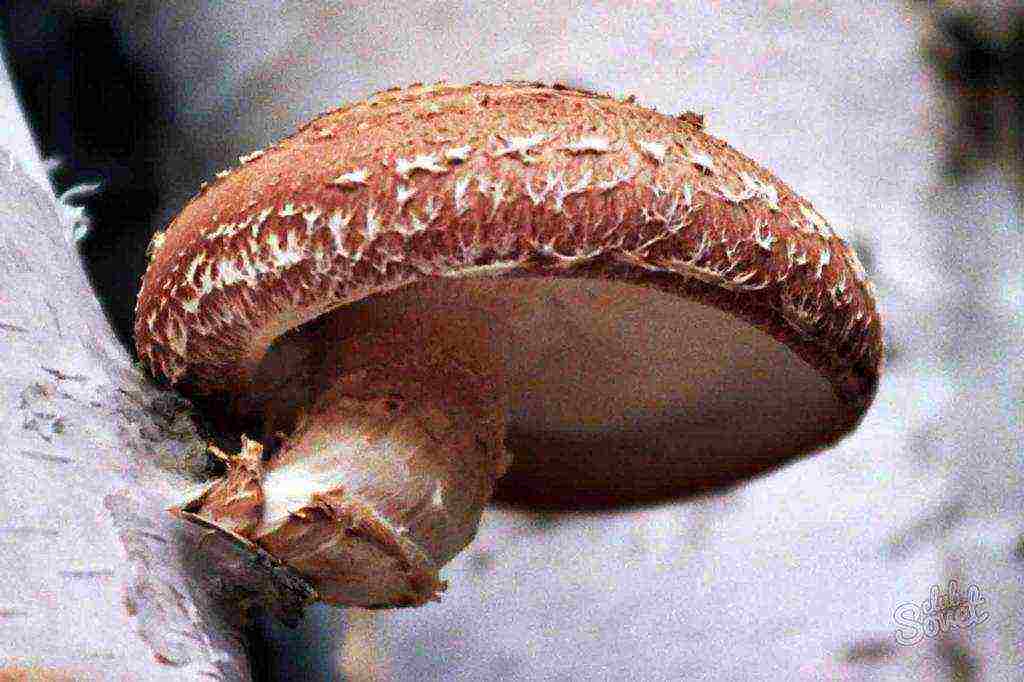
If you are unable to use logs to grow mushrooms, you can try growing the crop in sawdust. To do this, mix sawdust with pomace or bran. This will enrich the environment for growing mushroom colonies. Before planting the mycelium, boil the sawdust in water for 1 hour, this will kill bacteria and other fungi.

To plant mycelium, simply place it on the substrate and cover the container with plastic wrap. At the initial stage of mushroom germination, the temperature should be + 20 ° C. After mushrooms appear on the surface of the sawdust, you can reduce the heating to + 16-17 ° C. When the culture finally takes root, the substrate will turn white. You can use substrate bags for planting mycelium. Before planting the mycelium, it is necessary to make indentations with a long stick and fill them with mycelium.
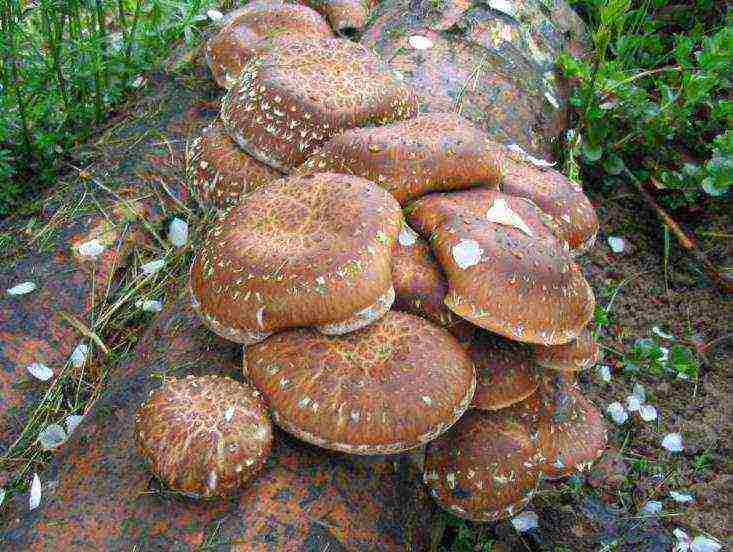
You can use straw as a substrate. To do this, it is boiled for 2 hours in a cloth bag, and then the mycelium is planted in it. It is best to stack the mycelium in layers. Place the mycelium on a layer of straw and cover it with a substrate. You can sow in three rows. In this case, you need to wait for 2-3 harvest waves.

Special blocks for growing shiitake are available for sale. They already contain in their composition all the nutrients and fertilizers. There is no need to boil them before planting mycelium.

Compared to oyster mushrooms, shiitake mushrooms grow slowly, so it can take 6 months from planting to harvest. Reduce humidity to 50% before picking mushrooms. This will allow a dense film to form on the surface of the caps, which will prevent damage to the mushrooms.
Lentinula edible (Lentinula edodes) is a lamellar mushroom that grows on a tree. Its light or dark brown cap reaches 30 centimeters in diameter. It is attached to a white fibrous stem, cylindrical in shape. Shiitake can be translated as “broadleaf mushroom”. Its growth zone is Japan, China, Korea. "Black Forest Mushroom" can be called one of the main ingredients of most dishes of the countries of Southeast Asia. Research has revealed a large number of useful and medicinal elements in it. Cultivation of shiitake mushrooms in the open air takes from 180 to 360 days, in a greenhouse the ripening period is much shorter.
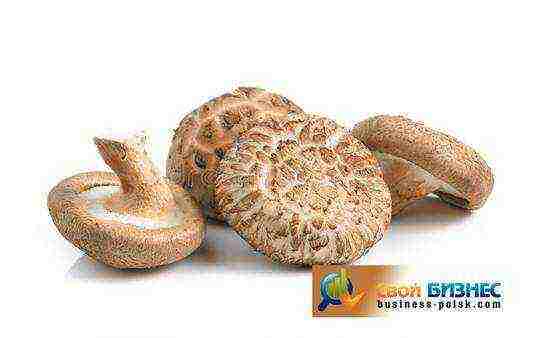
Home business organization
The name of the cultivated culture indicates the peculiarities of the choice of soil - it is used for shiitake wood. For growing mushrooms on your own plot, you can choose intensive or extensive methods. Growing one crop under conditions close to natural takes from six months to a year. Moreover, each square meter of rotten, wet wood used for planting will bring 250 kg of a delicious mushroom every year.
Shiitake mushrooms tolerate frosts down to -25 ° C.At the onset of spring, the place of planting of mushrooms must be covered with a film for the earliest possible warming and maintaining the necessary moisture content of dead wood.
The optimum moisture content of the substrate is 60%, with an increase or decrease in this indicator, the yield of the mushroom place decreases.
Growing a Japanese mushroom on rotted wood trunks with a one-time replanting of mycelium in the trunk is more profitable. Fruiting mycelium will last from 3 to 5 seasons. Regardless of where the mushroom planting will be, in a horizontal or vertical position, in tiers or in one row, it is necessary to maintain the temperature and humidity of the logs.
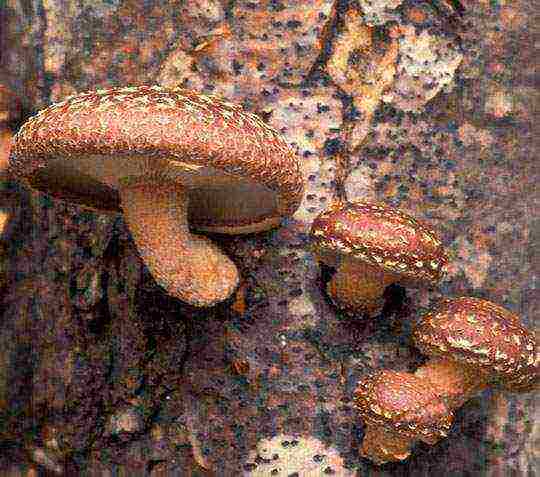
The intensive method, which requires special conditions for forcing the mushrooms, reduces the ripening period to 1-2 months. The method of accelerated germination requires strict maintenance of the temperature and moisture content of the soil (substrate). After the first outgrowth, the fruiting of the mycelium lasts for several more weeks. Only the yield with intensive forcing is no more than 20%, despite the fact that sawdust of deciduous trees and residues after threshing grain crops serve as the soil.
Attention! Softwoods are not used for growing mushrooms. The optimal choice of substrate or blocks for planting shiitake mycelium is oak, maple, beech.
Which mushrooms are more profitable for a home business: shiitake or cherries
Growing cherries and shiitake trees on logs of deciduous trees that have begun to decompose from high humidity is similar only at first glance. Daily fluctuations in air temperatures in central Russia are not terrible for the Korean forest mushroom. Fruiting lasts from May until the time when there was no serious frost on the soil. As a rule, this time coincides with the holiday of the Intercession (November 14). At this time, the last root crops are removed from the fields.
- Cherries are more whimsical, their yield is lower.
- Shiitake mycelium grows much slower than oyster mushroom mycelium.
- Due to the duration of the formation period of Japanese fungi, mold begins to compete with mycelium.
- Fruiting of oyster mushrooms is provoked by a decrease in temperature.
- For shiitake, you just need to water the ridge regularly.
Having weighed all the pros and cons, it turns out that shiitake is more convenient for home cultivation. Cherries require expensive climatic equipment.
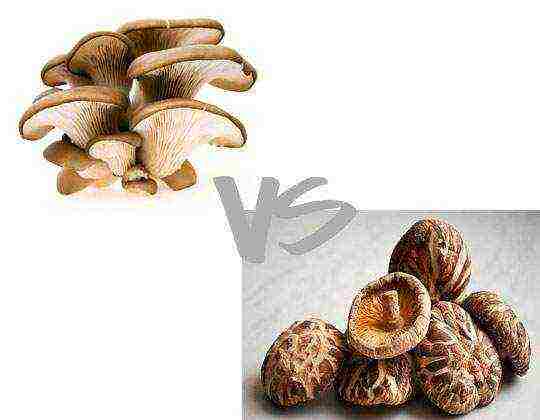
Chinese way of growing shiitake
The Chinese method of growing mushrooms on tree trunks differs in that logs are located with a diameter of 7-15 cm in a horizontal position. Until the middle, they sink into the ground. For convenience, the trunks of felled trees are divided into segments of 100-120 cm. If it is necessary to save space on the site, the trunks are folded according to the principle of well rings with the difference that there is a gap between adjacent logs on each side.
Preparation of trunks for planting is as follows:
- trunks during the preparation period should spend several years outdoors in rain, snow;
- the constant moisture content of the wood at the time of planting the mycelium should be 38-42%;
- the lack of moisture in the woody soil is compensated by abundant irrigation before the introduction of planting material;
- holes with a diameter of 1.2 cm are drilled on the trunk to a depth of 4 cm;
- the distance between the holes in each row is 10 cm;
- the rows are located at a distance of 7 cm from each other.
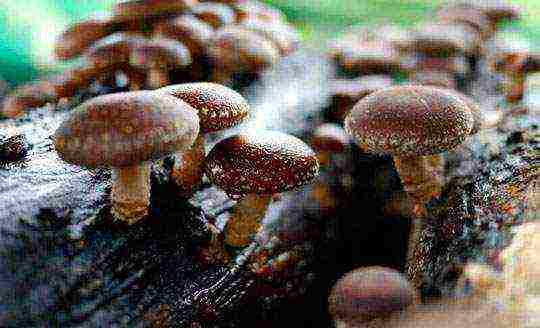
The mycelium is introduced into ready-made, sufficiently moistened holes. The height of the woodpiles, which are essentially a mushroom garden, does not matter. For 30 days, this vertical mushroom plantation must be covered with plastic wrap to create a greenhouse effect for the incubation period under it. The germination temperature can range from +20 to + 26ᵒС.
Advice! The carbon dioxide in the wood interferes with the good fruiting of the shiitake. To get rid of it will help 12-hour soaking in water t ° from + 13 ° to +18 ° C.The absence of air bubbles at the end of the water procedure indicates the absence of CO2.
It is possible to determine the readiness of the trunks for fruiting by the following signs:
- the absence of a sonorous sound when hitting the barrel with a hammer or other solid object;
- mycelium is visible on the cuts of the trunk;
- when using halves of the trunk, white islets of mycelium in the cross section.
Growing mushrooms on trunks dug into the ground makes it easier to maintain the necessary moisture, which contributes to the natural articulation of wood. Accordingly, the temperature inside the trunk is higher than that of the surrounding soil. This means that frosts are not terrible for an impromptu mushroom ridge.

To obtain mushrooms with a dense pulp, caps and a delicate (to taste) leg are formed at temperatures low for this mushroom from +10 to +16 ° C and an air humidity of 60 to 75% uncharacteristic for many regions with a temperate climate. Daily fluctuations in air temperature also improve the taste and appearance of shiitake. Therefore, during the fruiting period, the mushrooms are not covered with a film.
After collecting the mushrooms of the first growth, it is necessary to change the climate for the trunks, lowering their humidity to 30-40% and increasing the air temperature. During the 2-month recovery period, daily temperature fluctuations should be in the range from +16 to +22 ° С.
Interesting! The same logs can be used for growing shiitake for 3-5 years. During this period, mushrooms weighing 5 times less than the mass of the wood used will be collected from them. Conclusion: beech and oak have a high density and weight, which means that with the same area of birch and oak ridge, more mushrooms will be collected from the first.
Growing at home
When used for growing lentinula edible premises with adjustable modes of temperature, humidity, illumination, fruiting will be year-round. The acceleration of the forcing of mushrooms is achieved to a greater extent due to the heat treatment of the substrate.
Not all stages of industrial bending can be reproduced at home, which affects the result. Stages of work:
- the sawdust substrate is enriched with essential nutrients.
- The soil is poured into packages of agril, material for covering the beds.
- The bags with the substrate are placed in hot water for a quarter of an hour.
- The soil is sterilized for 24 hours at a temperature of 60 ° C.
- He must spend 72 hours in an environment with a temperature of 50 ° C.
- The cooled sawdust, inoculated with mycelium, is transferred to sterile 3-liter jars.
- Glass incubators are sealed with cotton stoppers.
- For 2 months, the banks are moved to a room with a temperature varying from + 17 ° C to + 20 ° C.
- The substrate with the germinated mycelium is returned to the air-permeable bags.
- No procedures are performed for two weeks. During this time, the mycelium will collect the substrate into a single dense block.
- After that, it must be sent, for about a day, to water for moistening.

After soaking the substrate collected by the mycelium a dense block, in two weeks you can wait for the first harvest.
Making substrate blocks for home mushroom farming
It is wood that is needed to grow mushrooms, so all leaves are removed before the branches are chopped. The processed raw materials do not require additional processing, they are used immediately for the preparation of the substrate. The amount of soil is determined by the volume of the used polypropylene or agryl bag.
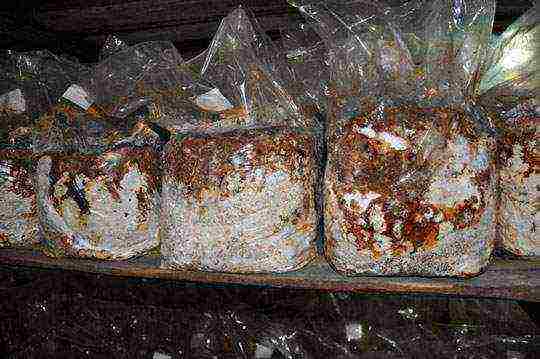
The substrate is heated, pasteurized. Only after that mycelium is planted in it. The bag is the ideal environment for mycelium development, similar to greenhouse conditions. The size and shape of the bag determines what the substrate block will be.
Approximate calculation:
- when stuffing a package with a width of 25.5 cm, the block will turn out to be 16 s in diameter;
- optimal height - 28 cm;
- volume - 5 l;
- the wet mass has a weight of 2.2 kg.
To moisten 5 liters of sawdust substrate, 200 ml of water is sufficient.
Attention! Barley in the composition of the substrate increases the yield. It is recommended to add 250 g to each package. barley grains. To moisten the grain-enriched sawdust, 350 ml of water is required for each block.
You can use blocks 2 times smaller in volume to grow shiitake. Low pressure plastic bags are suitable for them. They can withstand heating temperatures up to +110 ° C.
Formation of blocks with mycelium:
- a thoroughly mixed mixture of sawdust, grain, water is packed in bags;
- from 30-40 cm strips of padding polyester 5-7 cm wide (not used), tight rolls 2-3 cm in diameter are rolled;
- they are wrapped with threads;
- a homemade cotton plug is fixed at the top of the bag with twine or twine.
- for 8-12 hours, sealed bags are left for even distribution of moisture, grain swelling;
- when sterilizing the substrate in an autoclave, it is necessary to set the temperature regime to + + 110 ° С for 3 hours.
- after the substrate has cooled down, it is necessary to introduce the mycelium into it and close it again with a cotton plug.
Attention! Sterility should be at all stages of mushroom planting. To transfer the mycelium to the ground, it is better to use a spoon treated with a chlorine-containing composition.
One packet requires 1 tablespoon of grain mycelium. It can be poured into a bag, after tying it around a cotton plug, spread the mushroom seeds throughout the entire volume of the substrate by vigorous shaking. It remains only to give the package with loose soil a certain stable shape. The corners bent at the bottom of the bag can be fixed with tape.
Growing in a greenhouse
Growing shiitake in a greenhouse is justified in areas with cold, short summers. After the thermal preparation of the substrate, the introduction of nutrients into it, and high-quality moisture, the blocks with mycelium are left for germination in a closed form. After 6-10 weeks of being in greenhouse conditions at temperatures from + 17 ° C to + 22 ° C in an environment with a humidity of ≈ 55%, the bags are opened and additionally moistened.
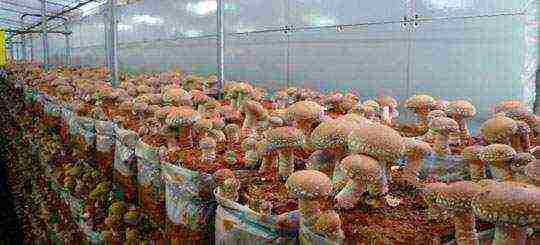
With the frequency of watering, the first mushroom growth will not be long in coming. Shiitake will appear in 2 weeks. But until that time, it is necessary to free the substrate associated with the shiitake mycelium from polyethylene and lower the air temperature to + 10 ° С to + 16 ° С. Each block at this temperature for 3-6 months can be regularly harvested.
The main threat to the crop is mold inside the blocks with fungi and other microorganisms that can destroy or weaken the mycelium. It is to combat their pathogens that prolonged heat treatment of the substrate is used before planting mycelium in it.
If it is necessary to sterilize a large mass of substrate, an alternative to heat treatment of the prepackaged soil is to fry it with a total mass. True, for carrying out all the other stages, packing, distributing the mycelium, a sterile room will be required, otherwise all efforts will be in vain, because microorganisms develop much faster than the shiitake mycelium.
For greenhouse cultivation, as well as for home cultivation, dense plastic bags with a volume of 1 to 6 liters and cotton plugs are used to ensure air circulation.
Attention! For planting the mycelium, the substrate temperature should be in the range from + 20 ° C to + 30 ° C.
Preparation of planting material
To grow shiitake mushrooms in a greenhouse or at home, you need to infect some organic matter with them. The most suitable material for this is grain crops. It is most convenient to germinate mycelium in wheat or barley grains. The mycelium envelops the grains, germinating in them, as a result of which dense grain blocks are formed, infected with the mycelium.
Before inoculation - the introduction of grain mycelium into the substrate, these blocks must be kneaded into grains. The proportion of grains to soil mass is 2-5%.

Mycelium purchase
The purchase of mycelium must be done in specialized seed stores. Here you can also purchase nutrient compositions for enriching the substrate. In the Leningrad Region, shiitake mycelium is sold by seed shops in Peterhof on Krasnye Kursantov Boulevard, 63 and in Otradnoye at the addresses: Central Street and Novaya Street, 10.
You can purchase mycelium for growing shiitake in Chelyabinsk and Nizhny Novgorod, Cheboksary and Novosibirsk.
Substrate preparation
Shiitake Substrate Formulation Rules - Base, Nutritional Supplements, Acidity Optimizers. The basis is the sawdust of deciduous trees, their size should vary within 2-3 mm. Alder, aspen, birch, poplar, maple, beech, oak and other local wood species are suitable for shredding. Fungi do not grow on conifers, therefore pine and spruce sawdust is not permissible as part of the substrate.
Such a strict criterion for the size of sawdust is justified by the fact that the small ones will create a too dense layer that impedes air exchange, and there will be a lot of oxygen between the large elements of the woody soil, which is a favorable environment for the development of competitive microorganisms and mold, given the necessary humidity and temperature of the environment for growing shiitake.
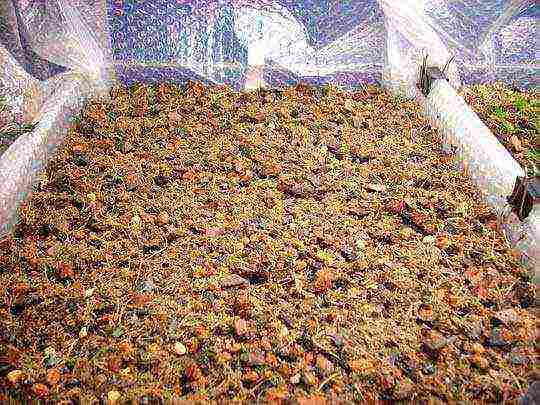
No fertilizers are required for growing mushrooms! The nutrients for shiitake are cereals (their grains or flour), organic residues after threshing. Depending on what crops grow in the area, you can use beans, corn, rice, barley. Rye, wheat, millet and so on.
The content of gypsum or chalk is permissible in the substrate. They are required to normalize the acidity of the soil. They can make up from 10 to 40% of the total volume.
Product distribution channels
Edible Japanese mushroom, resembling white champignon in taste and aroma. Its peculiarity lies in the fact that it is spicy, so the Shiitake dish does not need to add pepper. This makes it possible to sell it to factories that produce semi-finished mushroom soups, sauces, seasonings for main courses. In the dried form, edible lentinula retains its useful properties and aroma, but somewhat loses its taste. The pungency remains if the raw material does not pass repeated soaking in hot water.
Raw mushrooms are used in almost all dishes of the national Japanese, Chinese, and Korean cuisine. The second, highest priority sales channel will be restaurants specializing in national dishes from Southeast Asia. Shiitake can be used, after preliminary soaking, in European dishes as an alternative to porcini mushrooms.
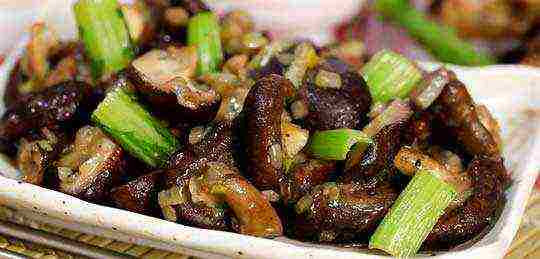
The Japanese mushroom is widely used in pharmacology and traditional medicine - this is another opportunity to establish a permanent distribution channel. The spectrum of action of the nutrients contained in shiitake is quite wide - these are:
- reduced fever;
- the fight against viruses;
- treatment of the heart and stomach;
- cleansing the blood;
- increased immunity and stress resistance;
- normalization of blood circulation;
- lowering sugar;
- breakdown of cholesterol;
- removal of toxins from the body;
- strengthening of potency.
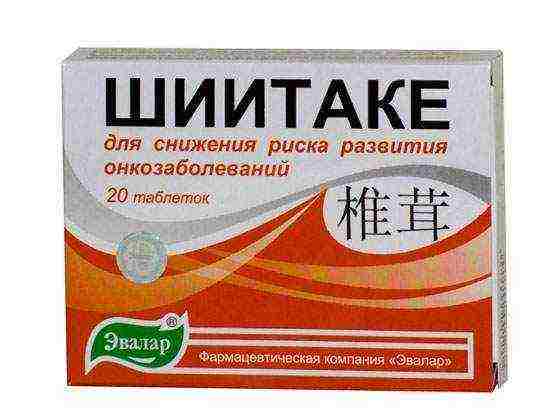
As an adjunct to the main drug treatment, shiitake is recommended for the treatment of the upper respiratory tract, poliomyelitis, smallpox, flu, HIV. In Japan, this mushroom rich in trace elements is called the elixir of longevity. Fungal therapists recommend this mushroom for:
- cleansing the gastrointestinal tract;
- reducing excess body weight;
- to maintain normal blood sugar levels for diabetics.
Foodservice outlets specializing in diet food can also be considered as potential customers.
One of the sales channels can be considered cosmetology concerns that use this mushroom for the preparation of anti-aging creams, lotions, masks.Scientists have repeatedly proven the benefits of shiitake in the fight against certain skin diseases.
Costs and return on business
Competition for growing shiitake in Russia is extremely low, which at the moment explains the high cost of the product. The price of fresh mushrooms varies from 700 to 1000 rubles. per kilogram (for wholesale). For a kilogram of dried Japanese mushroom, you can gain from 2.5 to 3.5 thousand rubles. With the maximum return from one square meter of wood at the lowest prices, it will be possible to gain 175,000 rubles.

For homeowners in the private sector, harvesting the wood needed to grow shiitake will cost the cost of firewood. Deadwood is wood for which you will have to pay a purely symbolic price when drawing up a contract for the sale and purchase of forest plantations, provided for by the Civil Code of the Russian Federation. For each family living in a house with stove heating, the state assumes a consumption of 15 cubic meters of hardwood per year.
Prices in each region are set by local authorities, on average, together with delivery, you will have to spend 5-6 thousand rubles for the purchase of wood.
- To install 3-4 square mushroom "wells", 1 cubic meter of wood is enough, which in its pure form can be equated to 400 rubles.
- Purchase of mycelium from 180 to 400 rubles,
- oats - 250-350 rubles.
- A spacious greenhouse covered with polycarbonate (if purchased in winter) costs around 15,000 rubles.
- Agrospan (agril) roll - 360 rubles.
- The cost of padding polyester depends on its density. The price of a running meter varies from 20 to 70 rubles.
All the costs of arranging a mushroom plantation are within the 20-thousandth budget, if there is an enclave and a well with drinking water on the farm. Under the most unfavorable circumstances, the recoupment of all costs is ensured from one successful transaction. Well-established distribution channels guarantee the success of your home business.
Shiitake planting technology


